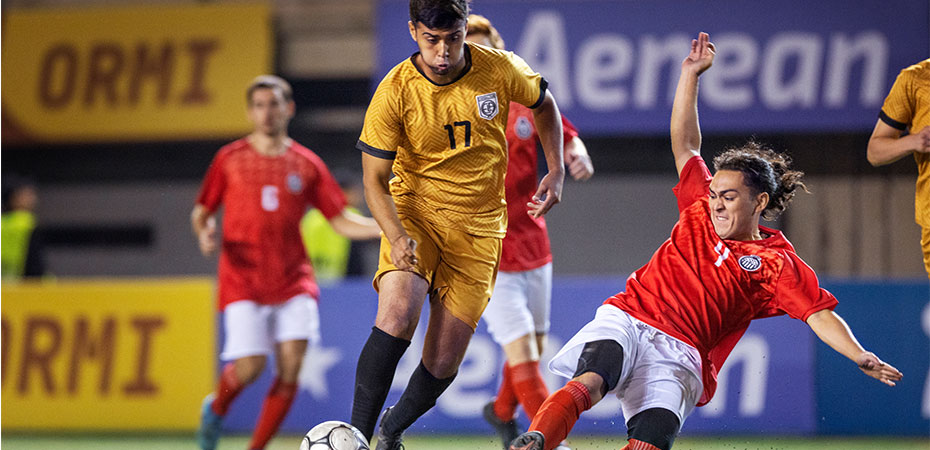Welcome to the latest episode of Gowling WLG’s listen up podcast, where we look at a range of topics trending in the legal and commercial landscapes.
Khemi Salhan: Welcome to our podcast on brand protection and sport. This podcast is part of our sports sector podcast series. I’m Khemi Salhan, a Principal Associate in the Gowling IP team.
Kate Hawkins: And, I’m Kate Hawkins, also a Principal Associate in the Gowling IP team. So we’re going to run through some of the core topics that we think any in-house sporting legal team will need to know. In particular, we’re going to look at:
- Brand protection strategies;
- Sponsorship;
- Marketing; and
- Enforcement.
Khemi: Although some of these topics might sound like they’re not specifically IP related, each topic goes to the core of how best to protect your brand in a sporting context.
Kate: So why are we talking about this? Well, we both took on the role of Brand Protection Manager for the Birmingham 2022 Commonwealth Games, and so we have first-hand experience of some of the opportunities and challenges that legal teams face when dealing with brand protection in a sports context.
Khemi: Absolutely. There’s so much to consider, and between our work both in-house and in private practice, we’ve worked on quite a diverse range of matters. Shall we get into it?
Kate: Yeah. So, first, let’s talk about brand protection strategy. I think it’s best to start here because setting a strategy will likely inform a number of the other choices you make around marketing and enforcement.
Khemi: I completely agree. When we were creating the brand protection strategy for the Games, I think there were a number of things that we knew we needed to consider. For example, we knew that we were responsible for protecting the brand both through registrations and enforcement; we knew there were sponsor interests that we would need to protect; and we knew that we would need to engage with a large number of stakeholders.
Kate: Absolutely. I think it was really helpful to identify clear objectives about what we wanted to achieve through the brand protection strategy at the outset. This gave us something that we could always come back to and helped to maintain a level of objectivity when we got stuck into the every-day management of it all. As a practical tip, I would recommend keeping the strategy separate from any practical guidelines. The strategy document can set out the objectives/ aims/ plan and any timelines, for example all of the big picture stuff, and then your guidelines can set out practical steps such as reporting lines, assessment criteria for enforcement, and key contacts, so the nitty gritty of day-to-day implementation.
Khemi: It may also be that other people from other teams or other businesses need to feed into different parts of either of those documents, so keeping them separate could save time overall in terms of getting both the strategy and the guidelines signed off – and it also helps to maintain version control.
Kate: On that note, it’s definitely worth considering who will need to input or agree to these documents.
It’s important to ensure that all key teams within a business buy into the brand protection strategy. Although this could take time to ensure that the relevant people have had the chance to review and comment on the document, it’s a good opportunity to tease out any sticking points and agree priorities before the strategy is put into practice.
Khemi: Absolutely. It’s best to ensure that everyone is singing from the same hymn sheet so that you reduce the potential for any conflict between the preferred approach and a supplier, venue owner or sponsor’s approach further down the line.
Kate: I’d also be thinking about who is going to see the strategy and guideline documents, as you may need to word them slightly differently. For example, since the guidelines relate to practical steps, you may need to share them with parties such as sponsors, broadcasters, or other stakeholders so that you can demonstrate to them what steps you are taking to protect the brand. This is a great way of showing the business’s commitment to brand protection.
Khemi: In terms of the content for the strategy document, I’d say that it’s important to pin down what your business’s approach is going to be to brand protection. Some businesses want to take a robust, tackle all potential infringements approach, whilst others want to take a softer approach in order to maintain fan engagement.
Kate: For sure, and those boundaries and enforcement priorities are likely to be different for different types of businesses. So, if you are running a sporting event that only happens once a year for a limited period of time, your approach to brand protection might be slightly different to a sports club that has a repeated, seasonal program.
Khemi: The strategy document should also set out who is responsible for the different aspects/ elements of the strategy. Assigning responsibility means that the rest of the business knows who to come to if they have any queries about the strategy, or if they think something needs to be updated.
Kate: It also sets clear borders for the rest of the business as to the brand protection team’s remit. As the brand often goes to the core of a business, it’s essential to show what the team is and isn’t responsible for, so that it’s clear who is working on what. By ensuring that the right people are working on the right tasks, you also minimise duplication and maximise efficiency.
Khemi: Similarly, you’ll need to consider whether there are any international aspects to your brand protection program. The approach that you take in different territories will likely depend on where you play, sell merchandise, advertise and/ or have a significant fan-base.
The strategy document should identify those key territories, as this will then help you to manage your budget for both IP prosecution (whether registering trade marks or designs) and your enforcement budget.
Kate: On the registration front, I think listing those key territories upfront is a really good way to manage your budget. Sitting down with a trade mark or design attorney can be a good way of prioritising protection of those core brands in core territories. Once that’s locked down, you can then workshop creative ways to protect your rights in other jurisdictions.
For example, registering other aspects of your brand such as the appearance of mascots, font types, or other things that go towards your brand as designs in the UK or EU, can be a more affordable way of securing protection.
Khemi: Turning then to the guidelines, this document should look at how you will achieve the objectives set out in the strategy document. I would recommend having sections on enforcement, training, reporting lines, assessment matrixes or priority scales.
Kate: Again, assessment matrixes or priority scales are a really good way of maintaining consistency and objectivity when dealing with an infringement scenario. It can help you to decide whether you should really be sending the same type of robust letter to a children’s playgroup that have made their own bunting using your logo that you would send to a competitor to one of your sponsors, for example.
Khemi: It can really help to identify what is most important to the business and where efforts – and resources – should be concentrated. Speaking from experience, we know that a large part of managing brand protection is managing limited resources and time.
Kate: You mentioned training earlier, Khemi, and I actually think that’s a really important part of an effective brand protection programme. You can make all the plans that you want on paper, but do people really know what they should be looking out for when they’re on the ground, do they know who to contact if they see something, how to report it, do they know what they can do to help, and most importantly, do they know why it matters?
Khemi: I agree. Just like we mentioned with the strategy document, getting people in the business to understand why brand protection matters can be a game-changer in terms of what you can achieve. This may be training your marketing teams, sponsorship or commercial teams, and also training security staff working inside and around sporting venues. There may be practical reasons why you won’t allow flags and other branded materials into your stadium, but it can also serve a dual purpose of combatting ambush marketing.
Kate: Speaking of ambush marketing, let’s talk about sponsorship. Sponsors are integral to the delivery of sporting events. In return for their investment, they will often receive exclusive rights around kit, stadium or concession branding. They may also receive certain rights relating to hospitality, involvement and support of legacy or grassroots programs, and other marketing opportunities such as brand activations on site during matches or accompanying events. As a result, there are typically obligations within a sponsorship contract around how the sponsor can use the sporting right-holders’ brands.
Khemi: I think it’s really important for any brand protection specialist to fully understand their obligations to any sponsors, and also the scope of the sponsor’s rights. If a sponsor has exclusivity in relation to a certain category of goods or services, you are more likely to take firmer enforcement action against that sponsor’s competitors who may seek to associate themselves with your team, game or event. I’d recommend having a single document that lists out all sponsor rights, so that they are easier to track. This is particularly helpful where you have different levels or tiers of sponsorship.
Kate: Sponsors may also want you to explain and demonstrate some of the steps that you are taking to protect the brand – or, looking at it from their perspective, protect their investment. For example, they may want to understand the scope of your registered rights, details of any training you are delivering and to whom, your wider stakeholder engagement, and details of any key personnel changes. While sponsors will want to know about infringements and ambush marketing, there are other matters that go directly to the heart of a brand. This could be the way that a sporting business is tackling or responding to a particular political or regulatory issue for example, and changes in personnel such as much-loved managers, players or star athletes.
Khemi: One aspect of a sponsor relationship may also be around “clean” venues, and venue naming rights. “Clean venue” obligations are where a sponsor seeks undertakings that the venue where an event/ match is being hosted will be delivered free or clean of third-party branding. This is so that sponsor branding has greater prominence, and also so that those third parties do not have or benefit from rights that they have not paid for.
Kate: Clean venue obligations are easier to manage where a rights-holder operates out of their own stadium. For example, football clubs are able to police and manage the branding at their own stadium more easily. However, clean venue obligations are more difficult to comply with where there is temporary use of another venue. Audits will need to be carried out to identify all instances of third party branding, then responsibility for cover up will need to be allocated, and then responsibility for re-instatement of the previous branding will also need to be considered. The cost for all of this should also be considered and agreed up front as part of that venue use agreement.
Khemi: It’s also important to understand the scope of the sponsors’ rights so that you can ensure that they are not extending the scope of what they’re entitled to without paying for those rights. Sponsor creep can include additional branding at venues that it may not have paid for or unplanned activations on event/ match days. The important caveat to this is that you only want to be challenging sponsor creep where you are confident that it is outside of the scope of their rights, and where you have a robust enforcement programme against third party infringers. It would be damaging to sponsor relationships if the brand owner was to complain to a sponsor about their activity that goes beyond what has been agreed but hadn’t done anything to tackle third party infringements. It’s likely to make a sponsor question exactly what they are paying for!
Kate: Another important commercial aspect of any sporting brand protection strategy is marketing and communications. All marketing and comms go directly to the core of your business’s brand and its reputation, i.e. the thing that you are working so hard to protect. As a result, nearly all marketing and communications has a brand protection angle. As a baseline, we recommend having at least a weekly meeting with your marketing and communications teams so that you can hear what they are working on, what they’ve got in the pipeline and any challenges they may be facing. Even better would be to spend a day a week sitting with them so that they can see you, and you are available to them.
Khemi: I agree, Kate. Building those relationships is so important.
Kate: Integration amongst the brand protection/ legal and marketing and comms teams just creates a better flow of information. Speaking from experience, often legal and brand protection can be seen as a blocker, but actually if there’s a better flow of communication, you can help support the marketing team to achieve what they want in a way that best protects the brand.
Khemi: One thing I found really helpful was to work with the marketing team to think about the different types of brands that we might need. There was a real desire to have community and fan engagement at the Games, but the core brands were reserved for sponsor and limited stakeholder use only. However, there were other brands that we could develop to encourage school engagement and local business engagement. By working closely with the marketing team, we were able to maintain sponsor rights whilst also encouraging wider engagement with the event.
Kate: As we’ve mentioned already, so much around sport and brand protection goes beyond simply registering trade marks and dealing with unauthorised use and infringements of your core brand. Businesses are increasingly expected to respond to cultural and political changes. Sometimes this can be fun, and may involve savvy social media posting, but brand owners should also think about the wider impact as to how this might be received by their fan-base. Sporting brands will also have to be able to respond quickly to actions taken by their star players/ athletes and/or their sponsors. Sometimes rights holders will take a very different view on a situation compared to its sponsors, and smart comms may be required to ensure that any press on a given issue does not result in a breach of contract or a breakdown in a relationship.
Khemi: Another instance where brands also need to be smart is about competitions that they run. These can be fun, quick ways of encouraging fan engagement, but sporting businesses need to be really clear about the terms and conditions that apply to any competition. It is essential that key terms are drawn to consumers’ attention in your advertising itself and that the scope of any prize is clearly and explicitly stated. There is a temptation to shorten t&cs, particularly where the competition is being run on social media. No business wants the reputational damage associated with an Advertising Standards Authority complaint, nor do they want to upset their fan-base by misleading them.
Kate: As a final note on marketing and communications, I also think it’s worth mentioning greenwashing.
Khemi: Absolutely, it’s such an important topic and one that lots of people in the sporting world will be thinking about.
Kate: My main pieces of advice on this would be to:
- avoid sweeping, absolute claims like “environmentally friendly” and take care not to give exaggerated impressions about your green credentials
- be specific about your initiatives – and tell the whole story – especially where leaving out the negative aspects of a sporting event will be misleading
- ensure you have robust substantiation and base claims on the full life cycle of your event
- take care with comparisons – these should be clear, meaningful and fully substantiated
- make sure you’re only using claims like “carbon neutral” and “net zero” in line with the regulators’ guidelines – if your claims are based on the use of carbon offsetting schemes, then that should be made clear.
Overstating what you’re doing, or trying to do, could result in a challenge not only to and upheld ruling from the Advertising Standards Authority, but also action from the Competition and Markets Authority and Trading Standards, which have a wider range of sanctions available to them, including the ability to issue fines and issue proceedings.
Khemi: Finally, let’s talk briefly about enforcement. As we’ve already mentioned, I’d really recommend setting out an assessment matrix or some criteria that will help you to consider what you will take action against. This will vary from business to business, but consistency in approach will make the lives of any brand protection team easier.
Kate: I completely agree. It may be that you’re delegating parts of your enforcement strategy to third parties, and this kind of approach mitigates the risk of parties taking different approaches to enforcement.
Khemi: I think there are also some things that you can do to help front-load the burden of enforcement. Think about different types of template letters that might need to go out, and also identify which matters you could deal with through a phone call. If your sporting event is over a weekend, it may be difficult to get hold of the right people who can deal with your concerns, so ensuring that you have taken prompt action shortly after is likely to reduce the risk of repeat offending. There are some elements as well that brand owners might not be able to deal with themselves. For example, if unauthorised parties are ticket touting or offering counterfeit merchandise, you may need to get local weights and measures authorities such as the police or trading standards involved to address these issues.
Kate: I’d also recommend having a clear strategy for dealing with online enforcement. For example, using online brand protection tools like our Saturn service may be an efficient way of tackling online infringements for counterfeit goods, fake websites and social media pages and illegal streaming. It’s likely that sponsors and key parties such as broadcasters will expect you to take steps to reduce the risk of this.
Khemi: I agree, and it’s so much easier for third party infringers to offer their goods online. They can often make them quickly and cheaply and don’t have to stand outside all day. One thing that businesses will often have to consider with online brand protection is the re-sale of genuine goods. It’s important that any brand protection strategy does not result in take downs for legitimate re-sale of goods that individuals have purchased and may be re-selling.
Kate: Yes, this is something that could upset fans. So, we hope that this has given you some food for thought around brand protection and sporting events. Thank you very much for listening to our podcast.
Khemi: Thank you!
Thanks for joining Gowling WLG for this podcast. If you enjoyed this episode, be sure to check out our website at gowlingwlg.com for more useful insights and resources.
And don’t forget to subscribe to ensure you join us for our next episode.
Gowling WLG is a multinational law firm formed by the combination of Canada-based Gowlings and UK-based Wragge Lawrence Graham & Co in February 2016, in the first multinational law firm combination co-led by a Canadian firm.
Please visit the firm link to site






